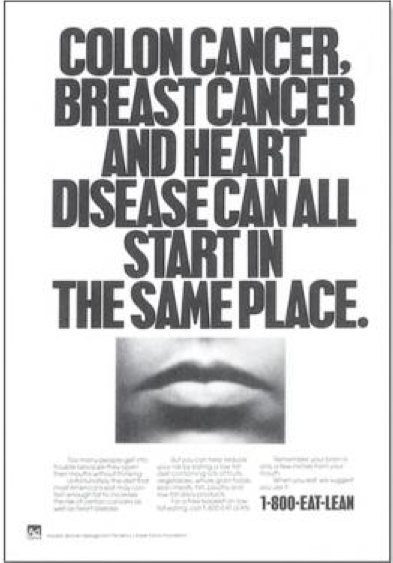Health promotion: obesity
 When discussing the prevention of obesity in society, it is clear that there are several factors that need to be discussed: our modern-day sedentary lifestyle, availability of high fat and high caloric foods, sugary drinks, and portion size. Those things seem relatively easy to address, so why have we not been able to prevent a global obesity epidemic?
When discussing the prevention of obesity in society, it is clear that there are several factors that need to be discussed: our modern-day sedentary lifestyle, availability of high fat and high caloric foods, sugary drinks, and portion size. Those things seem relatively easy to address, so why have we not been able to prevent a global obesity epidemic?
One of the reasons that it is difficult to change cultural norms. Watch the video below on obesity around the world and then take a look at the research below that examines the extent to which public health campaigns for a healthier diet are successful.
SLT & the Media Effects Model
On average, children in the United States view 15 television food advertisements every day, 98% of which are low in nutritional value, averaging out to 5,500 messages per year. Another study has shown that only 2% of advertisements (out of the 10,000 food advertisements that a child watches on average yearly) are about fruits and vegetables. Could media be used to a more positive effect to encourage healthy eating and fight the obesity epidemic?
Social Cognitive Learning Theory has been applied in mainstream television series in order to change people's behaviour. The use of soap operas for this goal became known as the Sabido Method. In a study by Valente et al (2007) the researchers measured the effect of a storyline on a popular American television show, ER (Emergency Room) in which an obese, low-income African American teenage boy is diagnosed with hypertension.
The show dedicated three episodes to integrating a discussion of teenage obesity, hypertension, and heart disease, as well as the doctor explaining the 5 A Day plan to the young teen. The 5 A Day plan recommends five portions of fruit and vegetables per day. By a series of random phone surveys, the researchers found that after watching those three episodes of ER, people gained higher awareness and knowledge of 5 A Day, and were reported to engage in some change in their eating behaviours.
Beaudoin et al (2007) studied the effects of the STEPS media campaign in New Orleans which was targeted at African-American women aged 18 to 49. In order to develop the media campaign, focus groups made up of African-American women who were overweight were used to determine what type of message would be the most effective. The focus groups indicated that, although the cost was a factor in influencing fruit and vegetable consumption, time constraints appeared to be more important. In addition, because time constraints were a barrier to physical activity, it was important to incorporate physical activity into an existing daily routine instead of approaching it as a separate task. The message of the campaign was tailored to fit the lifestyle of the target population. For example, one television ad showed an African-American couple in their 30's sitting at a kitchen table. The man says that it is hard and time-consuming to eat healthy foods. The woman provides him with a bag of pre-cut salad. Afterward, they happily eat the salad. The setting is familiar, the language is straightforward and the accent is from New Orleans. Eating healthy does not need to be laborious and time-consuming.
Once again, using random-digit telephone dialing, interviews were conducted. The results showed improvements in people’s attitudes related to a healthy diet and physical activity.
Health Belief Model
The Health Belief Model argues that when an individual perceives a threat from a disease (measured by susceptibility to the disease and the severity of disease) and understands the benefits of preventive action, then the individual is likely to take preventive action. The second component of the model is that the individuals need to identify perceived barriers to a change in their behaviour. The final important aspect of the HBM is self-efficacy - an individual's belief that he or she is able to perform the advocated behaviour.
 One implementation of the HBM was the Project Lean (Low-Fat Eating for Americans Now) Campaign (Samuels 1993). The first step was to inform the target population about the risks of high-fat diets. The poster on the left is an example of the type of media campaign that was used to highlight these risks. As you can see on the poster, there was also a hotline which people could call to get more information about the effects of a high-fat diet and to get a free brochure with suggestions for dietary change.
One implementation of the HBM was the Project Lean (Low-Fat Eating for Americans Now) Campaign (Samuels 1993). The first step was to inform the target population about the risks of high-fat diets. The poster on the left is an example of the type of media campaign that was used to highlight these risks. As you can see on the poster, there was also a hotline which people could call to get more information about the effects of a high-fat diet and to get a free brochure with suggestions for dietary change.
Researchers determined the barriers to change through a series of focus groups. One of the perceived barriers to changing their diet was the fear that low-fat food was "inconvenient" and "tasteless." In order to develop self-efficacy in the community, chefs and food journalists took part in the campaign to demonstrate how to easily prepare tasty low-fat foods. The response was very strong with over 300.000 calls coming through the hotline
ATL Inquiry: The debate about government control
Another way to deal with obesity is by having the government impose bans or higher controls on what we eat. Recent new legislation around the globe includes:
- Europe leads the world in eliminating trans fats
- Calories will be printed on all menus in restaurants and takeaways (Ireland)
- Doctors call on workplaces to ban sugary drinks
- A potential new nutritional label to simplify health information
What do you think? Do you think that the best way for society to tackle this is to have the government take over and eliminate factors that have contributed to the obesity epidemic? Why do you think so? See if you can find any evidence to support your opinion.
There is a real debate in modern society about the role of government in the promotion of healthy eating. Students will take different positions in the argument. I have them come to the board and we list the "pros" and the "cons" of government bans.
You may also want to have them read the following article: Is banning sugary drinks worthwhile?
Evaluating prevention strategies
Prevention strategies are difficult to assess. Here are some of the key concerns.
- Many of the studies are short-term and thus do not determine the long-term effects of the programs.
- The studies are reliant on self-reported data. This means that the researchers have to trust that the participants are in fact being honest about their dietary habits. There is little to no way to verify their claims. Because of the nature of the studies, the social desirability bias or other demand characteristics may affect the data.
- It is difficult to establish a cause-and-effect relationship between a campaign and a change in eating behaviour.
- The outcomes for most campaigns are still relatively small (averaging around 8%). It is not clear why the other 92% are not reacting to the campaigns.
Checking for understanding
1. According to Social Cognitive Learning Theory, which factors are important for a role model to exhibit in order to make it more likely that someone will imitate their behaviour?
There are several factors that increase one's likelihood of imitating a role model. The behaviour that they exhibit should be rewarded. This leads to vicarious reinforcement. In addition, it is better when the model is either an authority figure (someone that is respected) or a member of one's own in-group. Finally, the behaviour that is exhibited has to be something that the individual can replicate. In this case, if you cannot afford the foods that are being eaten in the serial, then you will not imitate the behaviour.
2. What is an "optimism bias?"
An optimism bias is a cognitive error that causes a person to believe that they are less at risk of experiencing a negative event compared to others. For example, a smoker believes that she is less likely to contract lung cancer or disease than other smokers. It can also be an overestimation of a positive behaviour. For example, people tend to overestimate just how much exercise they do per day or just how nutritious their daily diet is. This is a barrier to preventing obesity because people won't change their behaviour if they don't believe that they are not exercising enough or eating right.
3. What are the three components of the Health Belief Model?
The first component is knowledge of the risks to oneself from a certain behaviour - in this case, a poor diet. The second component is a recognition of barriers - either actual or perceived - to changing one's behaviour. For example, the cost of eating a healthy diet or not knowing how to cook and being dependent on prepared foods. Finally, there is self-efficacy - that is, one's feeling of empowerment to overcome the barriers that would lead to healthier behaviour.
4. How did Samuels (1993) evaluate the success of the LEAN program? What is the problem with this approach to evaluation?
The LEAN program was evaluated by measuring the response to the Hotline. The problem with this approach to evaluating the program is that it does not indicate the extent to which people actually changed their eating habits.

 IB Docs (2) Team
IB Docs (2) Team
